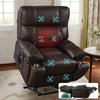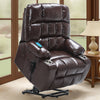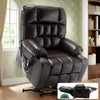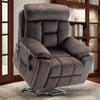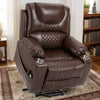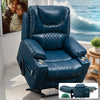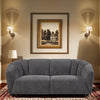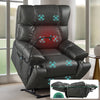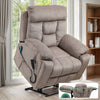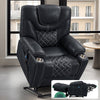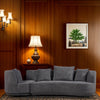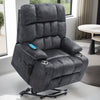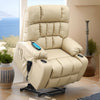Understanding the Special Needs of Elderly Individuals
Assessing the Elderly's Mobility and Comfort Requirements
As we age, our bodies change. This affects how we sit and move. Seniors often face issues like:

- Reduced mobility
- Joint pain
- Muscle weakness
- Balance problems
These challenges make it hard to sit down or stand up. They also impact comfort when seated for long periods. It's crucial to assess each person's needs. This helps in choosing the right seating solution.
Some key factors to consider are:
- The senior's height and weight
- Their ability to move independently
- Any specific health conditions they have
- Their daily activities and routines
By understanding these needs, we can find chairs that offer proper support and ease of use.
The Importance of Ergonomic Design in Seating
Ergonomic design is vital for senior seating. It ensures comfort and prevents health issues. Good design can:
- Reduce back pain
- Improve posture
- Enhance circulation
- Prevent pressure sores
Ergonomic chairs support the natural curve of the spine. They distribute weight evenly. This reduces strain on the body. Features like adjustable heights and reclining options are important.
They allow seniors to find comfortable positions easily. Armrests provide support when sitting or standing. Padded seats and backrests add comfort for long sitting periods.
Remember, what works for one person may not work for another. It's essential to try different options. This helps find the best fit for each individual's needs.
The Best Lift Chairs and Recliners for Seniors in the United States
Key Features to Look for in Lift Chairs and Recliners
When choosing lift chairs and recliners for seniors, certain features are crucial. These include:

- Lift Mechanism: This helps seniors stand up easily. Look for smooth, quiet operation.
- Multiple Positions: Chairs with various positions offer more comfort options.
- Easy-to-Use Controls: Large buttons and simple remote designs are best.
- Sturdy Construction: The chair should support the user's weight safely.
- Quality Upholstery: Durable, easy-to-clean fabrics are ideal.
- Battery Backup: This ensures the chair works during power outages.
- Heat and Massage: These features can provide extra comfort and pain relief.
- Proper Size: The chair should fit the user's body size and room space.
- Safety Features: Look for anti-tip design and emergency battery backup.
- Warranty: A good warranty protects your investment.
Choose chairs that meet the specific needs of the senior using them. This ensures comfort and safety.
Top-Rated Models and Where to Find Them
Several lift chairs and recliners stand out in the U.S. market. Here are some top-rated models:
- Pride Mobility VivaLift! Tranquil: Known for its smooth lift system and plush comfort.
- Golden Technologies Comforter: Offers excellent lumbar support and easy controls.
- La-Z-Boy Pinnacle: Features a classic design with modern lift technology.
- Mega Motion Infinite Position: Great for those who need to sleep in their chair.
- Catnapper Power Lift: Offers a wide range of positions and sturdy construction.
These chairs can be found at:
- Medical supply stores
- Furniture retailers specializing in senior products
- Online marketplaces like Amazon or Wayfair
- Manufacturer websites
Always try the chair before buying if possible. Many stores offer in-home trials. This helps ensure the chair meets the senior's needs. Remember to check for delivery and setup services too.
Implementing the Right Seating Solutions: Tips and Best Practices
Installing and Maintaining Lift Chairs and Recliners for Longevity
Proper installation and maintenance are key to the longevity of lift chairs and recliners. Here are some tips:

- Installation:
- Choose the right location: Ensure enough space for full recline and lift.
- Check power sources: Place near an outlet, but avoid tripping hazards.
- Follow manufacturer instructions: This ensures proper setup and safety.
- Regular Maintenance:
- Clean upholstery regularly: Use methods recommended by the manufacturer.
- Check mechanisms: Look for signs of wear or unusual noises.
- Lubricate moving parts: This keeps the chair operating smoothly.
- Inspect electrical components: Look for frayed wires or loose connections.
- Daily Care:
- Avoid overloading: Stay within the chair's weight limit.
- Use gently: Avoid rough movements or jumping into the chair.
- Keep food and drinks away: This prevents spills and stains.
- Professional Service:
- Schedule annual check-ups: Have a technician inspect the chair yearly.
- Address issues promptly: Don't ignore strange noises or malfunctions.
By following these practices, you can extend the life of the chair and ensure it remains safe to use.
Understanding the Legal and Safety Aspects of Seating Solutions for the Elderly
When implementing seating solutions for seniors, it's important to consider legal and safety aspects:
- Medicare Coverage:
- Lift chairs may be partially covered if prescribed by a doctor.
- Check eligibility requirements and documentation needed.
- ADA Compliance:
- Ensure seating solutions don't obstruct accessibility in the home.
- Consider how the chair fits with other mobility aids.
- Fire Safety:
- Check that upholstery meets fire safety standards.
- Keep chairs away from heat sources and have a clear evacuation path.
- Electrical Safety:
- Use surge protectors to prevent electrical damage.
- Avoid overloading circuits with multiple medical devices.
- Fall Prevention:
- Choose chairs with stable bases and anti-tip features.
- Ensure the floor around the chair is clear and non-slip.
- User Training:
- Provide clear instructions on chair operation to the senior and caregivers.
- Post emergency procedures near the chair.
- Regular Inspections:
- Schedule routine safety checks of the chair and surrounding area.
- Keep maintenance records for warranty and insurance purposes.
By addressing these aspects, you create a safer environment for seniors using lift chairs and recliners. Always consult with healthcare providers and local authorities for specific guidelines.








